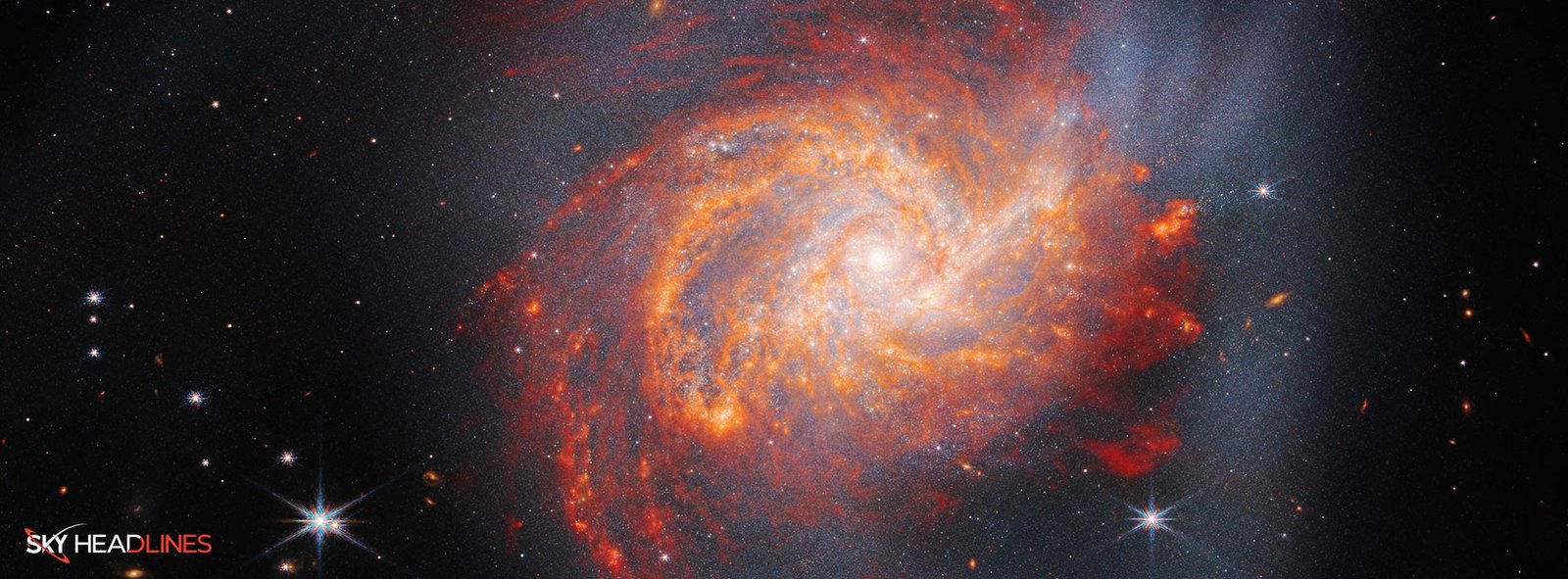The NASA/ESA/CSA James Webb Space Telescope has captured this incredible image of a galaxy NGC 3256. Situated approximately 120 million light-years away in the Vela constellation, this galaxy, similar in size to our Milky Way, resides within the Hydra-Centaurus Supercluster.

NGC 3256: A Cosmic Collision Unveils an Interesting Past
NGC 3256 appears as a swirling mass of tightly wound spiral arms enveloped in a hazy cloud of light. What we see here is the aftermath of an ancient cosmic collision. Astronomers believe that around 500 million years ago, two spiral galaxies of equal mass crashed into each other, forming this peculiar galaxy. The turbulent history of this galaxy is evident in the long strands of dust and stars extending from its main body.
What Secrets of Stellar Birth Does Webb Telescope Unveil in NGC 3256?
The merger of these galaxies gave rise to young stars illuminating small dust particles, emitting infrared light beautifully captured by the instruments on board the Webb telescope. These regions exhibit striking shades of red and orange. Furthermore, stretched tidal features can be observed in the distance, primarily composed of stars pulled from colliding galaxies.
Galaxy Collisions: Astonishing Effects of Interstellar Mixing and Blending
When envisioning a galaxy collision, one might imagine stars colliding and exploding dramatically. However, galaxies contain vast expanses of space between their stars. During a crash, the star clouds of the merging galaxies pass through one another and intermix, akin to two clouds of smoke blending. Nevertheless, the gas and dust within the galaxies do mix, resulting in astonishing effects, like NGC 3256.
The collision that gave rise to this galaxy triggered a burst of intense star formation, as evident in the brightest regions of the image. These young stars emit their most glowing light at infrared wavelengths, as infrared light can penetrate the galaxy’s dust, making them ideal subjects for study by the Webb telescope.
Can Studying Nearby Merging Galaxies Change Our Understanding of Galactic Evolution?
This discovery contributes to a broader examination of star formation and the growth of black holes in merging galaxies located nearby. The objective is to revolutionize our understanding of how galaxies evolve. By capturing detailed images of a few bright infrared galaxies, such as NGC 3256, astronomers can begin to piece together the intricate histories of neighboring star-forming galaxies using the capabilities of the Webb telescope.
The image combines data from Webb’s Near-InfraRed Camera and Mid-InfraRed Instrument, which provide stunningly detailed views of NGC 3256 at infrared wavelengths. Furthermore, the Hubble Space Telescope conducted previous observations of NGC 3256 at visible wavelengths, revealing evidence of this cosmic collision.
Hubble and Webb’s images are juxtaposed in this composite image, allowing viewers to compare the visible and infrared views of NGC 3256 using a slider tool.
This Galaxy is a Captivating Portrait of the Galactic Collision
This captivating image showcases NGC 3256, a galaxy shaped by a violent collision between two spiral galaxies. It illustrates the mingling of stars and the mixing of gas and dust during such clashes. Henceforth, the burst of star formation triggered by this collision can be observed in the brightest areas of the image, which shine brilliantly in infrared light.
Additionally, this discovery and similar studies aim to revolutionize our understanding of the evolutionary processes taking place in nearby merging galaxies. By examining a handful of vibrant infrared galaxies like NGC 3256, astronomers can unravel the complex histories of neighboring star-forming galaxies using the advanced capabilities of the Webb telescope.





